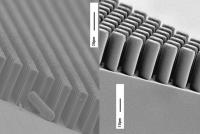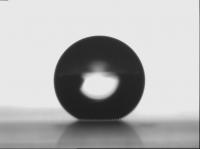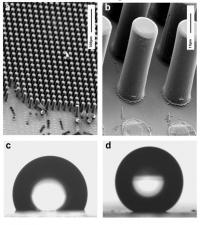Polymer microposts: Photolithographic patterns
The ability to create a bed-of-nails type structure, but with "nails" that are one-to-ten millionth of a metre in diameter, allows superhydrophobic effects to be compared to theoretical predictions. One simple method is to use a process borrowed from the microelectronics industry called photolithography. First, a light sensitive polymer liquid (a photoresist) is deposited onto a spinning substrate so that it forms a thick film. The photoresist is then exposed to intense light through a glass mask with a pattern on it and this changes the properties of the film in selected locations so that some parts become insoluble in a special solution (a developer). The developer is then used to remove the parts of the film which were not exposed to the light, leaving behind microscopic posts. Finally, the surface is hard-baked to convert these posts into a durable surface and a hydrophobic surface coating is applied to create the superhydrophobic structure. Read more about the process in the publication below.
Publications
![]()
The use of high aspect ratio photoresist (SU8) for super-hydrophobic pattern prototypes,
J. Micromech. Microeng. 14 (10) (2004) 1384-1389.
View postprint pdf





